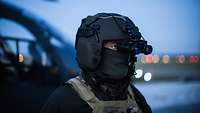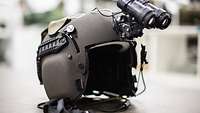Before the end of this year: Delivery of the new helicopter flight helmet system
Equipment- Date:
- Place:
- Koblenz
- Reading time:
- 2 MIN


It is modular, quieter and comes with ballistic protection – the new flight helmet system offers a whole slate of improvements. It is set to be delivered to all Air Force and Army helicopter pilots in the second half of 2024. The amount of 1,850 helmet systems meets the current demand of the forces.

The new shell design of the helmet provides noise shielding, which results in improved communication
Bundeswehr/Johannes LochererThe commercially available system is intended to replace the previous model for all helicopter pilots across all fleets. After successful certification, the contract for series procurement was concluded in January 2024, with the complete delivery to be accomplished within this year.
Depending on which unit uses the helmet, individual ancillary equipment is required.
The supplied accessories can be used as needed. The so-called face shield, for example, provides reliable protection against various weather conditions such as cold winds. The dust goggles offer additional protection.

The outer side of the helmet features mounting rails which can be used to attach required ancillary equipment
Bundeswehr/Johannes LochererThe outside of the helmet is equipped with mounting rails, which can be used to attach equipment such as flashlights or other small objects.
A major innovation is the ballistic protection: The flight helmet system shields the face from fragments, unlike the previous model. So in future, the helicopter crew will be better protected during operations.
Thirty of the new helmets were thoroughly tested ahead of the procurement. Especially the improved communication is a big step forward. The flight helmet system features a much more effective sound insulation, which is achieved by an optimized shell design in which the earplug is attached directly inside the helmet shell. The memory foam pads are firmer and adapt very well to any head and neck shape. These pads are designed in such a way that they mold to the wearer’s contour and maintain their shape during wear.
The sound insulation is enhanced by the supplied communication earplugs, or CEP. These earplugs are used for communication, for example with crew members, and are worn inside the ear directly underneath the helmet. In addition, they block out ambient noise.
One of the test pilots was particularly enthusiastic about this innovation: "When the aircraft first started up, I was surprised at how quiet it can be on the inside – and how much clearer and quieter the radio then is." According to him, the main advantage is that good communication will still be possible even during weapon use. "Also, this will cause significantly less noise stress for me and my fellow soldiers," the captain explains.
"All in all, the new helmet offers many advantages, and all soldiers who do not yet have one can look forward to receiving one," the test pilot affirms.
by Heike Westhöfer